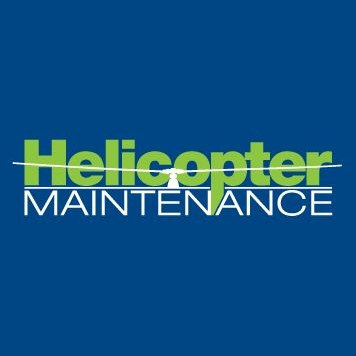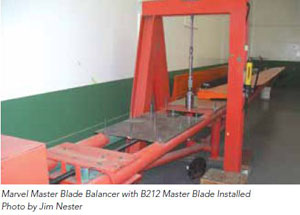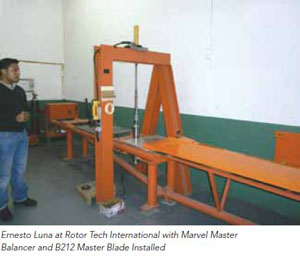
Track and Balance - The Main Rotor for Now

Jon Robbins – Contributing Author
Before I say anything else, I want to point out that there is a lot of information on the Internet that will clearly explain the physics of helicopter blade track and balance. All of the companies that make balancing equipment have excellent information available. Bear in mind, I’m an old guy and when I started working on helicopters, although there was software, there was no internet and PCs were only a dream.
Not since the days of flag tracking (and yes, I’ve done that for main and tail rotors) have we had such a wide selection of electronic balancing systems, yet you still hear people say that solving track and balance issues although mostly science, is also part magic/luck/art and so on. I don’t believe that there’s any part of rotor smoothing that isn’t science. However, I am willing to admit that sometimes it’s very difficult to pin down a problem, especially when the problem turns out to be something other than what you normally find. Worthy of note is the fact that sometimes, although we are performing rotor track and balance, it is not always track or balance that causes the symptoms we are trying to fix through normal rotor-smoothing techniques.
You Have To Compromise
I’m not talking about the times you perform track and balance when everything works just the way it should. That is just us doing our job — but for example, what do you do with a rotor track scenario where everything is good at a hover, good at 40 knots, good at 60 knots, and good at 80 knots but then gets worse at 90 kts and then gets smooth again at VNE? In a situation like that, you can’t make it good everywhere, so you’ve got to compromise. If it’s a corporate or EMS ship, you might want it smoothest at cruise. If it’s a utility helicopter that does lift and bucket work, perhaps 40 to 60 knots might be the range you want for the best ride (besides hover).
There are blades that through age, wear or manufacturing differences end up flexing or twisting differently than other blades. Additionally, the more blades a rotor system has, the effect of one blade is going to be less noticeable. I’ve seen this over the years to be more common with larger/older blades, or blades that are perfectly airworthy but have been repaired. If you’re fortunate enough to have spare blades, you can sometimes mitigate a problem like that by finding blades that are more suited to each other. We had a time-continued blade that was in our inventory for a while that was referred to as the “devil’s blade.” It never played well with others and eventually it was determined by our blade shop to have the incorrect mass/balance; i.e. the distribution of weight in a span-wise direction was incorrect. Due to a variety of factors, they can also be out of cord-wise mass/balance. Blade repair facilities have weighing machines that allow repaired blades to be weighed to determine if the distribution of weight span-wise and cord-wise is correct, based on “master blade” specifications. Obviously, the CG location in relation to the center of pressure is of critical importance in addition to total weight for a blade to “fly right.” Once repaired properly, it was put into service when we had a mismatched pair of blades. It’s doing just fine now and the blade that was removed is flying well on a different helicopter. We got lucky. It’s not the sort of issue you tend to see in newer blades from any manufacturer.

Blade Changes Over Time and Age
It’s also true that blades flying in perfect track may not always (or even often) give you the best ride. They are made by humans (inherent variability), they change with age and flight time, and they fly through the turbulence of the other blades. Making non-routine adjustments like splitting the track, tabbing opposite blades equal but opposite amounts, or sweeping a blade aft to alter lift (vertical vibration) can put us into the trial-and-error realm and although it might be considered luck if it works, it isn’t magic.
The problem with getting to that point is that it takes time to exhaust the adjustments you are being led to by the balancer and/or charts. Some of the software-driven balancers that use algorithms for specific models make this much easier than it used to be, if the particular ship fits the algorithm. Some manufacturers call for an initial move of intentionally putting the blades out of balance to see how the rotor responds. This is essentially adjusting the phase angle for each machine. Many balancers now do this automatically during the process of rotor smoothing. It just takes more time when some helicopters don’t quite “fit the mold.”
We also know that at least with turbine helicopters, the time-consuming part is startup, flight, getting the numbers, landing, cool down, then finding the pilot who has gone off to do pilot things in the short time it took you to make the indicated change. Depending on the level of maintenance done, three to five flights are pretty normal if everything goes well. I can recall making as many as 20 flights on one occasion. It was a long day, and that was just the main rotor. I should add that precision trim tab benders that use dial indicators to measure tab deflection are the best thing since sliced bread. It can be difficult to make very small tab changes, or return to a setting you had before without one.
Getting the Smoothest Ride
Sometimes getting the smoothest ride is not just an issue of making the correct adjustment to the easily adjustable parts (p/c links, weights, tabs, trunnion shifts, sweep, etc.), but comes down to how those adjustments affect the rest of the aircraft. All helicopters are subject to both harmonic and resonant behavior. When troubleshooting abnormal vibrations, the variables depend on the features of each airframe. Some have lead/lag main rotor dampers or flexible energy-absorbing transmission mounts. Some have articulated, teetering or ridged rotor systems. They all have their own set of common items to look at when things don’t go well. The goal of rotor smoothing for each is to reach the desired result (usually the magic 0.2 inches per second or below for one per rev lateral and vertical). Speaking of the 0.2 ips number, I can’t for the life of me find out where the value of 0.2 ips became the industry standard (in the early 1970s), but I do know that this number seems to represent that value below which most (and note that I mean not all people) won’t complain about a ship needing attention. You can look-up the ISO 10816 Vibration Severity Chart for non-rotating parts of general machinery and you will see that 0.2 ips falls just about at the edge between “continuous operation without restriction” and “condition acceptable for limited periods.” Obviously, the lower you get the numbers, the better off the aircraft and passengers are.
Speaking of resonance, many helicopters also have vibration absorbers or “hammers” that are designed to resonate when exposed to vibrations at frequencies particular to that rotor system. The Agusta 109E, the Eurocopter AS350/355 (has two locations and two types), the Bell 222 and many others have tunable or fixed masses that are there to absorb vibrations that cannot be removed by tracking or balancing the rotors. The “bifilar” assembly on many Sikorsky airframes is another example, along with the dynamic weights clamped to the blades as on the BO-105 series aircraft. A bothersome problem we see once in a while on Hueys/205 (especially with extended height gear) is landing gear or skid tube shaking. Is this a vibration absorber, or a vibration resonator? All of this assumes proper maintenance to the landing gear has been done.

For our H-model Hueys with 212 rotor systems and extended height skids, the two-per-rev vibration is sometimes an issue. As with any “N” per rev that corresponds to the number of main rotor blades, much of this is a “feature” and not something you can eliminate. It is likely that the two-per-rev is causing the skids to shake in flight, so we end up feeling (and seeing) that in addition to the actual two-per-rev motion. We have ways of making the skid shake stop (let’s just say we can’t leave what we use for this on the aircraft after maintenance), so we know the ride gets better if the skids don’t shake. In these cases, the skids are resonating because some vibratory frequency, probably the two-per-rev, is “exciting them.” Once you have eliminated issues with blade track, landing gear and transmission mounts, wear in any rotating parts/flight controls or rigging, there isn’t much you can do for two-per-rev. One manufacturer of aftermarket skid tubes has a service bulletin and a kit for installation of weights to the skid tip foot pads. The purpose is to “de-tune” the skid gear so it won’t resonate quite so much from the inherent two-per-rev. We tried it and it can make a significant change in the feel of the ride. It reminded me of sitting in the passenger compartment of an Agusta 109E after finding both vibration hammers had broken and been replaced. They need to be tuned with a spectrum analyzer. I had replaced them and was going through the in-flight tuning process. It’s quite spectacular to watch them in action. When they were properly tuned you could watch them vibrate. With the covers off, when I put a foot on one so as to stop its movement, I got an immediate response from the pilot of “Hey! What just happened?” He could feel the difference in the ride immediately. Although they don’t normally need to be tuned, there is a special set of equipment that can be used to tune the hammers on the AS350/355 airframes that allows you to do it on the ground and avoid the in-flight trial and error method. Unlike the 109, you have no access to these in flight.
Aftermarket Equipment
Although almost all of the aftermarket equipment hung on and installed in helicopters today carries STC approval, we are always warned about ensuring that the installed items do not adversely affect the flight characteristics of the aircraft. An STC does not always assure that the system you are installing will have no effect on vibration. After installing a water tank on a UH-1H a while back, we found that after a successful round of track and balance, if we put in any more than a half load of water we would pick up a nasty two-per-rev as soon as we came off the pond. After much hair pulling and inspecting of transmission mounts and other suspects, we found we were not alone with this problem. Calls to another operator revealed they had had this problem and it was in fact shown to be the tank top and bottom skins were resonating when it was more than half full. The tank manufacturer, when shown the issues, made changes to the internal structures and the problem was solved. All was well, but it took some time and outside help to decide that it was not a rotor system problem due to the added weight of the water. Once again, resonance reared its head in an unexpected manner.
The “Whom” of Track and Balance
Lastly, I would say a little about the “whom” of track and balance as opposed to the “why” or “how.” There are things to be said about both mechanics and pilots when it comes to performing this function. Getting track and balance experience can be difficult for mechanics unless there are experienced people who are willing to show them how and why we do certain things. Interpreting the balance charts for some aircraft can be challenging, and the algorithm-driven, microprocessor-containing balancers do not always make the job as easy as it sounds in the balancer sales literature. Some track and balance charts are complicated by multiple trim tabs per blade or other features that alter what you are used to. Changing to a new balancing system or a different helicopter is best accompanied by some factory training. Make the guys who say how well their balancer works show you. When a new model helicopter shows up on the ramp for track and balance, the learning curve will be steep.
Pilots, forgive the technician who makes an adjustment that is backwards — it happens to all of us. Mechanics, please forgive the pilot who is a stickler for getting the absolute smoothest ride they can have when you know it was pretty good two flights ago. People really do sense vibration differently than one another. I’ve flown with pilots who are basically never happy with the ride, and others who just tighten their chin strap and say “that’s great” when you know you can make it smoother. At the end of the day, when the balance machine says it’s smooth, despite the fact that you’ve had to split the track to get there, it’s probably correct. I have had to say, on more than one occasion, “The machine says it’s done, it’s the best I can do.” (Well, maybe I did phrase it differently …)
 Jon Robbins has been an A&P mechanic for 31 years. He holds IA and private pilot and instrument airplane ratings. He supervises the helicopter maintenance program at CAL FIRE. Robbins is also on the HeliMx magazine advisory board. Contact him at jon.robbins@fire.ca.gov.
Jon Robbins has been an A&P mechanic for 31 years. He holds IA and private pilot and instrument airplane ratings. He supervises the helicopter maintenance program at CAL FIRE. Robbins is also on the HeliMx magazine advisory board. Contact him at jon.robbins@fire.ca.gov.
